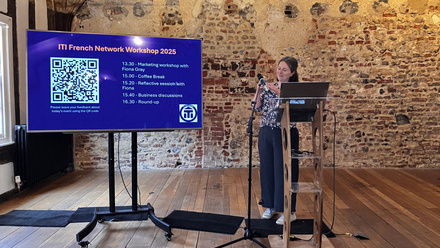An active approach to learning
Sue Farmery explains how taking an active approach to the way she watched a webinar has meant she has gained benefits she wasn't expecting.
When I set myself up as a freelance translator in 2021, I invested in a CAT tool and passed the associated certification exam. Feeling rather proud of myself, and thinking that I would simply fill in any gaps in my CAT tool knowledge ‘on-the-job’, I soon realised that I had a lot to learn. It quickly became apparent that to make the most of the tool I had invested in, I was going to have to commit to further CPD and the sooner the better!
I subsequently found a couple of webinars dedicated to the specific areas in which I wanted to become more proficient, and set aside some time to watch them. However, as I started to jot down notes while watching the first webinar, I had the dawning realisation that I would never be able to make head nor tail of these notes without the additional context of the webinar and that the tips and tricks that I was so desperate to apply in my own translation work were still far from my reach.
I decided that a different approach was required. In order to prevent information overload, I set aside ‘chunks’ of time across the week, and started to watch the first webinar again. But, this time, I paused the webinar frequently to take screen grabs that I subsequently pasted into a Word document and typed notes alongside.
I also simultaneously had my own CAT tool open and switched between this and the webinar to familiarise myself with the instructions. Re-creating the webinar actions with my own CAT tool also helped provide additional screen grabs, when the webinar didn’t go into sufficient detail. Whilst this approach took significantly more time and effort than my initial approach, I felt confident that I would be able to apply my learning not just when the material was relatively fresh in my mind, but at any point in the future.
When I had completed the first webinar, I was nonetheless rather overwhelmed by the amount of content my document contained. I was concerned that searching for key words wouldn’t necessarily work, as specific terms were often relevant to numerous actions. Then I remembered how I had managed the contents of my research dissertation in my recent MA in Translation, and created a Table of Contents that would automatically update as I added to the document over time.
As I came across additional issues or foibles with my CAT tool, I added further instructions to this document. Knowing I would probably be consulting this new document when something wasn’t going to plan, I was careful to try to make my new sub-headings as clear and obvious as possible, such as ‘No Open Termbase’ error when I have enabled termbase or ‘Dependency File Not Found’ error when opening a file!
You may think that I am a crazy CAT(-tool) lady ending up with over 30 pages of notes for a one-hour webinar, but when I find the elusive answer to a frustrating technological issue within minutes, I feel such a sense of relief!
It’s important to note, however, that I’m not advocating my specific approach here, but rather the importance of finding learning techniques that work for you personally. The ITI CPD User Guide states that ‘CPD is personal to the individual’ and I believe that this is true not only for what CPD you choose to undertake but also how you choose to undertake it. After all, what is the point of ‘ticking off’ a webinar on your CPD log if you cannot actively apply what you have learnt?






